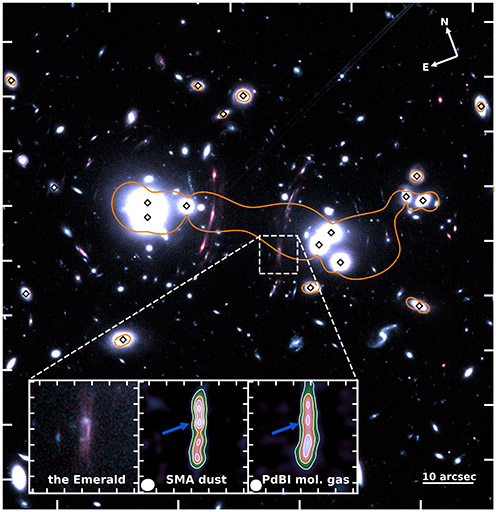29 November 2018
Intense Star Formation in the Early Universe
Early Galaxies:
An international team of researchers led by Raoul Cañameras (DARK, University of Copenhagen) has witnessed how the sites of the most intense star formation in the early Universe communicate with their surroundings through rapid gas exchange. This offers unprecedented insight into the rapid formation of massive galaxies, about 11 billion years ago.
The most massive galaxies experienced their most rapid period of growth when the Universe was only about 20% of its current age. Immense amounts of dust and gas gave rise to veritable fireworks of star formation, which have no peer in the Universe today. Most of these stars formed in giant, gaseous clumps, which were as massive as small galaxies today, but formed stars at rates that were a hundred times greater than those in the entire Milky Way. The relationship of these clumps with their surrounding host galaxies has so far been largely unexplored.
Researchers have now witnessed that these clumps do not form their stars in isolation, but must be in constant gas exchange with their surroundings: “This is the first time that we have seen the direct signatures of molecular gas being lifted off one of these clumps in a wind. This process can remove most of the mass of this clump within only a few million years”, says Raoul Cañameras, lead author of the new study. “We discovered this wind as a subtle spectral feature in a bright emission line of carbon monoxide from a galaxy about 3 billion years after the Big Bang, which was previously unknown, and which we nicknamed ‘the Emerald’.” Due to the fortuitous position of a cluster of galaxies between the Emerald and the Earth which acts like a magnifying glass, the team was able to study star formation on scales of a few hundred light years, which are otherwise only accessible within the most nearby galaxies.
Multiple gas components with a range of densities and temperatures are known from nearby star-forming galaxies, where gas conditions are most extreme within star-forming regions, and much less so in the diffuse gas inbetween. However, so far, most studies in the early Universe could only probe the most vigorously star-forming clumps in galaxies, which have the brightest lines. “Now we can directly study the less excited and less dense component outside of intense star-forming regions, from which new, massive star-forming clumps may form” says Cañameras. This second gas phase has the expected properties of intraclump gas, which must be distributed over larger scales, and outside of the strongly star-forming clumps themselves. The authors find that this gas can make up to about half of the total gas mass in these galaxies.

References
R. Cañameras, N. P. H. Nesvadba, M. Limousin et al., “Planck's dusty GEMS. V. Molecular wind and clump stability in a strongly lensed star-forming galaxy at z = 2.2”; accepted for publication in the Astronomy and Astrophysics journal; DOI: https://doi.org/10.1051/0004-6361/201833679
R. Cañameras, C. Yang, N. P. H. Nesvadba, et al., “Planck's dusty GEMS. VI. Multi-J CO excitation and interstellar medium conditions in dusty starburst galaxies at z = 2-4”; accepted for publication in the Astronomy and Astrophysics journal; DOI: https://doi.org/10.1051/0004-6361/201833625
